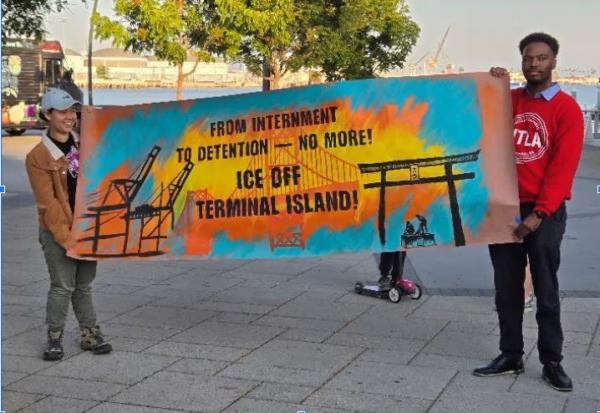If you think this ends with L.A., you haven’t been paying attention. This is Portland 2.0 — but scaled up, and aimed at the soul of American democracy…
Trump: Well, we’re going to have troops everywhere.
Reporter: What’s the bar for sending in the Marines?
Trump: The bar is what I think it is.
The 2026 and 2028 elections may have just gotten a lot more distant. First, the backstory.
It was around 2 a.m. on July 15, 2020, when Mark Pettibone, then 29, was walking home from a relatively calm Black Lives Matter protest in downtown Portland. He hadn’t done anything more provocative than wearing a black shirt; no slogans, no mask, no glimmers of violence. Yet moments later, an unmarked minivan pulled up alongside him. Out jumped several armed men in camouflage, with no insignia, slipped a bag over his head and kidnapped him.
“I was terrified,” Pettibone told reporters, his voice trembling with the memory. “It was like being preyed upon.”
He was shoved into the van, blindfolded, driven to the federal courthouse, interrogated, and held — with no Miranda rights, no paperwork, no explanation — for nearly 90 minutes before being released without charge or citation.
No uniforms, no accountability, no transparency, yet a citizen was stripped of his rights and dignity in a blurry high-stakes operation. And around the same time in Washington, DC, Trump was trying to talk General Mark Millie into having the National Guard shoot at protesters in that city.
This was not some fringe vigilante action. It was federal agents wielding brute force under cover of Trump’s executive order, agents whose silence spoke louder than any badge. The ACLU of Oregon called it an unconstitutional kidnapping; legal scholars said probable cause was nowhere to be found.
Yet Merrick Garland decided it wasn’t worth investigating or prosecuting. Let’s just move on. And so here we are.
As Donald Trump this week levels attacks on Los Angeles — sending in federal forces to “restore order” amid unrest provoked by ICE’s illegal tactics — Portland’s secret‑police saga shouldn’t just echo, it should ring alarm bells. If you thought that unmarked vans and invisible state power were confined to dystopian fiction, Pettibone’s story proves they already stalk our cities.
Trump and his neofascist sidekicks sending the National Guard into Los Angeles may look, on the surface, like another “law and order” stunt from a man whose political brand depends on hate and fear. But beneath the posturing lies something far darker and far more dangerous to American democracy.
This is not even remotely about suppressing unrest. Instead, it’s about setting an unconstitutional, anti-democratic precedent: that the President of the United States can deploy military force on a whim, against his political enemies, without state or local consent.
It’s about turning a democratic republic into an authoritarian stronghold. It’s about ending federalism — what political scientists and our Founders called our form of government — as we know it.
This is a test and a dress rehearsal. If he gets away with it, he will probably use this exact same formula — create a crisis worthy of television, bring in the feds, declare a state of emergency — to accomplish what he really wants to do.
For example, suspending the 2026 election. Yeah, that. Otherwise, Democrats might take the House and begin investigations of him that could lead to more prosecutions and convictions for his various crimes. And there’s no way he’s going to peacefully allow that.
For nearly 250 years, America has been guided by a simple democratic principle: that power flows from the people upward, not the other way around. When Jefferson wrote the Declaration of Independence, he was unambiguous:
“That to secure these rights, Governments are instituted among Men, deriving their just powers from the consent of the governed…”
We elect our sheriffs, our mayors and city councils, our governors and legislatures; those elections are our form of “consent.” They are closest to us, most accountable, and best positioned to determine how and when to protect public safety.
With very few exceptions having to do with the Civil War, World War II, and the defense of Civil Rights protestors, “keeping the order” through law enforcement has always been handled at the most local level possible so the people whose lives and daily activities are directly impacted have a say and can hold police and the people guiding them accountable.
But Trump has never cared for accountability. And now, like the autocrats he so admires — Putin, Erdoğan, Orbán — he is showing us that he sees local government not as a partner in governance, but as an obstacle to be crushed.
Let’s be clear: sending the National Guard into Los Angeles, especially when done over the objections of California’s governor and L.A.’s mayor, is a direct assault on one of the foundational principles of American democracy: local control.
This is the classic blueprint for dictatorship — using federal military power to override the will of elected local leaders — and it reflects the way fascism has begun in nearly every nation that has lost their democracy over the past century.
Even more glaring proof that this isn’t about “law and order” is the simple reality that Trump isn’t responding to a rebellion or foreign invasion. He’s responding, instead, to protests against ICE arresting people without warrants, a clear violation of the Fourth Amendment itself that says:
“The right of the people to be secure in their persons, houses, papers, and effects, against unreasonable searches and seizures, shall not be violated, and no Warrants shall issue, but upon probable cause, supported by Oath or affirmation, and particularly describing the place to be searched, and the persons or things to be seized.”
Trump is attacking the very same protests that are explicitly protected by our Constitution, reflecting the saying so often attributed to Voltaire (it actually came from his biographer) that it’s become an all-America cliché: “I may not agree with what you say, but I will defend to the death your right to say it.”
As the First Amendment makes explicit:
“Congress shall make no law … abridging the freedom of speech, or of the press; or the right of the people peaceably to assemble, and to petition the Government for a redress of grievances.”
That’s what makes this move so chilling. When a president treats constitutionally-protected protest as insurrection and sends in federal troops over the objections of state and local elected officials, he’s not preserving order: he’s causing disorder and, in the process, destroying our democracy.
We’ve seen this movie before; as mentioned, in 2020, Trump deployed federal agents in unmarked military gear to Portland and D.C. They tear-gassed peaceful demonstrators, beat and shot journalists, and abducted citizens off the streets. Americans shrugged. The media called it “controversial.” Merrick Garland decided other things were more important.
But the lesson Trump took from it was simple: it worked. He faced no consequences. The courts barely blinked and when Biden came into office Merrick Garland looked the other way. So now Trump’s doing it again, only this time bigger, bolder, and with clearer political intent.
Sending the Guard to L.A. sends a message to every mayor and governor in the country: If you oppose Trump, he can bring troops to your doorstep. And it sends a message to every American: If you protest, if you dissent, if you organize, you may one day be staring down the barrel of a gun flown in on orders from Washington, DC.
This is not hypothetical. It’s not alarmism. It’s a dry run for the eventual suppression of all dissent that seriously threatens the Trump regime. Just like in Russia, Hungary, or Turkey.
Deploying the National Guard for political purposes chills the First Amendment. Giving them the power to assault and arrest protestors breaks the Fourth Amendment. It tells the American people: stay quiet, or the military might show up.
That’s not democracy; that’s authoritarianism in plain sight.
Yes, Title 10 gives the president the power to federalize the National Guard during times of invasion, insurrection, or to overcome obstacles to enforcing federal law.
But Trump is taking it a step farther, giving Guard members the power to make arrests and point their guns at civilians, a clear and outrageous violation of the Posse Comitatus Act, enacted in 1878 in response to the violations of civil rights being perpetrated on civilians by the military during the post-Civil War occupation of the South.
That law explicitly forbids the military from turning their guns on civilians. Nonetheless, Congresswoman Maxine Waters is now so concerned that she’s begging Guard troops not to shoot at protesters. This should deeply shock every American.
As California governor Newsom posted to Xitter:
“We didn’t have a problem until Trump got involved. This is a serious breach of state sovereignty — inflaming tensions while pulling resources from where they’re actually needed.”
And let’s not pretend this is about safety. The same man who praised the “very fine people” who killed Heather Heyer when marching with torches in Charlottesville, who pardoned violent insurrectionists and murderers on January 6, who routinely echoes Hitler when he calls his political opponents “scum,” “animals,” and “vermin” does not care about public peace. He cares about control.
He wants to exercise domination and revenge against anybody (like California Governor Newsom) who dares stand up to him. And he’s now using federal armed forces to flex his power to lord over the rest of us in ways that would make our Founders puke…or revolt.
If Trump is allowed to again normalize the use of federal troops against American cities — particularly progressive cities that vote against him — it won’t stop with Los Angeles. Tomorrow it’s Chicago. Next month, New York. Then Seattle, Atlanta, Philadelphia. It becomes a pattern, then a doctrine: the president as enforcer-in-chief, sending muscle into any jurisdiction that refuses to obey.
That’s not federalism or anything remotely resembling law and order. That’s fascism.
And it’s not “coming” or “on its way.” It’s here, now.
And if he gets away with it, future presidents will do the same. The precedent — already weakly established here in Portland in 2020 — will be locked in. The checks and balances will have been destroyed.
That’s assuming there even are elections in the future.
As former Trump insider Lev Parnas said:
“According to my sources, there are discussions happening right now—within Trump’s most trusted circle—about invoking martial law if the protests ‘get out of hand.’ They’re looking for any excuse. Any video. Any act of violence. Any disruption. That’s all they need to justify a crackdown.
“And it gets worse. What I’m being told is that Trump allies—including elements connected to Proud Boys, III Percenters, and other far-right militia networks—are planning to infiltrate the June 14th protests. Not to support them. To sabotage them. Their goal? Create chaos. Spark confrontation. Trigger a response from law enforcement. And then hand Trump the justification he needs to clamp down.”
America is at a crossroads. We can pretend this is just another Trump stunt, something to be laughed at or dismissed, or we can recognize it for what it is: a direct assault on civilian government, an unconstitutional power grab, and a warning shot at the heart of democracy.
It’s time to stop normalizing the abnormal. Troops in the streets of American cities should send chills down our spine, not shrugs across the airwaves or the pathetic cheerleading we see on the billionaire-owned Fox “News.”
When a president uses the military against his own people to score political points, democracy itself becomes collateral damage.
And if Trump gets away with this like he did here in Portland in 2020, every new act of violence against the Constitution and people who disagree with him (Hegseth is now threatening to deploy Marines) will become less scandalous, more “normal,” and more likely to lead to the next crackdown.
And then the state of emergency. And then the suspension of elections.
The time to speak out is now, not after Trump’s seized a dozen more cities and imprisoned thousands of us. Call your members of Congress, and I’ll see you in the streets next Saturday.
Pass it along.















